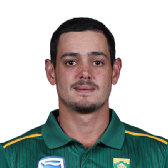Big picture
And so the cycle begins again. This is where the long, hard road to 2023 gets underway: in the shadow of Table Mountain, in the wake of an arduous Test campaign, with white-ball focuses drifting from 50 to 20 overs, as England and South Africa resume the format that brought them such contrasting emotions at the 2019 World Cup, already more than half a year ago.
With apologies to the hosts, whose own new beginnings we will get to in a moment, there's only one place to start this latest journey: with that finish, by the barest of all margins, in the final to end all finals at Lord's last July.
On an unforgettable afternoon, England's maiden World Cup victory was delivered amid a heady cocktail of grit, skill and (let's not beat around the bush…) brazen good fortune. But no matter how slender the difference between triumph and disaster may have been, the upshot was a resounding "mission accomplished": for the ECB, whose pivot to white-ball cricket in 2015 reaped the richest of rewards; for the captain, Eoin Morgan, in whose indomitable image the team had been forged, and for a battle-hardened squad, who held their nerve as the pressures of a once-in-a-lifetime home campaign threatened to choke their ambitions.
But that was then. Now the challenge is to park everything that's gone before, and begin the ascent all over … or at least sketch a rough route towards an ascent, while simultaneously redoubling a long-neglected focus on the Test squad's fortunes, and crafting a bish-bash-bosh outfit that is capable of challenging for consecutive T20 World Cups in Australia this winter, and in India the year after that.
Suffice to say, it promises to be a somewhat more erratic process than the defiantly linear route plotted out from 2015-19. Morgan himself will be 36 by 2023, and quite possibly sated by two more ICC campaigns in the interim, while the vast majority of the men who carried England to glory last summer will be north of 30 too. That in itself needn't be a bar to glory - Australia's 2007 World Cup-winners are a case in point - but the eternal tug-of-war between youth and experience is sure to come to the fore in the interim.
And that process begins in earnest in these three matches, as an exploratory squad dons its now-iconic light-blue kit for the first time since July, and sets about building for the future. The change in priorities has already been telegraphed by the decision to rest both Jos Buttler and Ben Stokes from these three ODI fixtures, ahead of next week's T20Is, not to mention the harsh but understandable axing of the 34-year-old Liam Plunkett, whose three wickets in the World Cup final would appear now to have been his international swansong.
At some stage in the coming matches, youth will doubtless be given its chance to impress. Tom Banton's exploits at the BBL confirmed the impression, already forged in county cricket, that England have landed themselves a ball-striker of extraordinary poise and power, while the likes of Saqib Mahmood and Matt Parkinson will surely be in line for ODI debuts before long. But when you're trying to break into a World-Cup-winning outfit, even one with competing priorities, it's only right that you should be made to wait and work for the honour. Keeping the fringe players hungry was one of the key reasons why England kept pushing their own standards throughout that four-year rise.
And then there's South Africa … a team, like England, that have had more than their fair share of World Cup heartbreak over the years, but who chose the summer of 2019 to finally strike rock-bottom. But whereas in previous tournaments, there were rain rules and all-time epic showdowns with which to mitigate their shortcomings, this time the excuses ran dry, as an unready and distracted squad crashed out at the group stage, effectively in the first week of competition after a trio of defeats against England, Bangladesh and India.
And so South Africa's new era begins with Quinton de Kock installed at the helm, and with the likes of Dale Steyn and Chris Morris overlooked, a reaction perhaps to the passive squad selections that contributed to the team's malaise at the World Cup. However, with the future of Faf du Plessis still to be decided, and AB de Villiers once again intimating his desire to be involved at the T20 World Cup, there's a sense of impermanence to South Africa's top order, and one that's not simply related to the length of time they might spend at the crease.
That said, Rassie van der Dussen is a player whose form is in the ascendancy, following his 98 in the Johannesburg Test, while David Miller, who turned 30 this year, knows that this could be a make-or-break season if he is to convert a South Africa career that has been promising for too long. All eyes, however, are sure to be on Temba Bavuma, the cause celebre of the Test series. He is potentially slated to come in at No. 3, but played the most recent of his two ODIs in 2017 (albeit he averages 80.50 in the format with a century on debut against Ireland).
At least South Africa can fall back on their recent(ish) history against England. They won their last home ODI series in 2016 - one of just three bilateral series that England lost in four years en route to their World Cup win, and did it the hard way too, coming from 2-0 down to win 3-2. De Kock, auspiciously, was right at the forefront then as well, scoring a brace of hundreds including a series-turning 135 at Centurion.
But whatever happens, this first staging post on the route to 2023 is unlikely to serve up many definitive performances. The road to India promises to be long, winding and, quite probably, a bit bumpy too. But you've got to start somewhere, and there's no time like the present.
Form guide
(last five completed matches, most recent first)
South Africa WWLLW
England T*WWWL
In the spotlight
Welcome back, Moeen Ali, we've missed you. Amid last summer's euphoria, Moeen's retreat from prominence was one of the sadder subplots, as a player who had done so much to drive his team's renewed standards lost form and focus at precisely the wrong moment. On the one hand, a batch of unexpectedly bowler-friendly wickets contributed to Moeen's downfall, as England consistently opted for the extra seamer throughout the World Cup. But his ropey run of form with the bat was every bit as relevant - aside from one six-laden cameo against Afghanistan, he failed to pass 20, or strike at more than a run a ball, in his four other innings. A winter out of the spotlight has seemingly revived his hunger, and he could yet be in line for a Test return in Sri Lanka. But leaving aside any long-term thoughts about 2023, Moeen's all-round attributes, and tactical nous, will be invaluable assets for twin T20 World Cup campaigns.
With Kagiso Rabada resting after an arduous recent workload, the timing of Lungi Ngidi's return to fitness could hardly be better. Following the reported loss of five kilograms at a strength-and-conditioning camp, Ngidi is set to slot straight back in as South Africa's pace spearhead, having recovered from the hamstring strain that scuppered his participation in the Test series - and contributed to their early World Cup demise. It's easy to forget that he is only 23, given the wealth of injuries that he has already encountered since his debut three years ago, but in every way possible, he's the sort of talent that his country needs to be able to rely upon as they seek to rebuild their fortunes.
Team news
After the undignified speed with which South Africa's resolve collapsed in the final three Tests, de Kock's first task as captain will be to shore up his squad's fragile confidence - and how better to do that than to lead from the front with the bat? Having shown glimpses of his best form with half-centuries in each of the four Tests, de Kock is set to open alongside Reeza Hendricks, in a line-up that has changed immeasurably since the World Cup debacle. Even in the absence of Rabada, the likely starting XI contains four black Africans and two other players of colour, which will help to rebalance South Africa's transformation targets after they slipped behind during the Tests.
South Africa (possible): 1 Quinton de Kock (wk, capt), 2 Reeza Hendricks, 3 Temba Bavuma, 4 Jon-Jon Smuts, 5 Rassie van der Dussen, 6 David Miller, 7 Andile Phehlukwayo, 8 Beuran Hendricks, 9 Lutho Sipamla, 10 Tabraiz Shamsi, 11 Lungi Ngidi
There's a familiar look to England's batting, even in the absence of Stokes and Buttler, with Moeen restored to the middle order after his winter of franchise-based down-time, and Jason Roy back in action after a shoulder injury sustained at the Mzansi Super League. The bowling line-up could feature both Curran brothers for only the second time in ODIs, as well as a rare outing for Chris Jordan, who made a late bid for a World Cup berth in the Caribbean last spring, but hasn't featured in an ODI since 2016. Banton's ODI debut may be deferred if England want to take another look at Joe Denly, in the wake of his late World Cup axing.
England (probable): 1 Jason Roy, 2 Jonny Bairstow (wk), 3 Joe Root, 4 Eoin Morgan, 5 Joe Denly/Tom Banton, 6 Moeen Ali, 7 Sam Curran, 8 Chris Woakes, 9 Tom Curran, 10 Chris Jordan, 11 Adil Rashid
Pitch and conditions
The weather is expected to be a scorcher, and the pitch at Newlands is expected to be flat - having served up an average of 5.73 runs per over since the start of 2015, which equates to a first-innings total of 286.
Stats and trivia
In keeping with their richly competitive Test record since readmission, England and South Africa are almost neck and neck in their ODI head-to-head. South Africa currently edge it, with 29 wins to 27 in 60 matches, with one tie and three no-results.
At Newlands, however, South Africa are a tough team to beat. They have won 30 matches out of 36 at the venue, including all five of their contests with England, including the decider in 2015-16.
England's star performers on that South Africa tour were an intriguing pair. Long before he became persona non grata for the World Cup, Alex Hales starred with the bat with five 50-plus scores, including a century and a 99; while Reece Topley's left-arm seam gleaned 10 wickets at 21.90.
Both Woakes and Rashid are on 99 ODI caps, and set to raise three figures during the series.
Quotes
"For this series, we just want to win. There is a lot of time to give a lot of opportunities but for now, it's important for us as a team that we just get a series win. That's more important at the moment for the morale of the team. In the future, we will be giving more opportunities when we decide its best for the team."
Quinton de Kock says that momentum is the key to South Africa's revival
"I think we use ODIs as a great opportunity to build strength in depth throughout our squad. This series, as a starting point, will see guys come in and make their debuts and give people opportunities to stake a claim for positions that have been cemented for sometime now."
Eoin Morgan on competition for places


